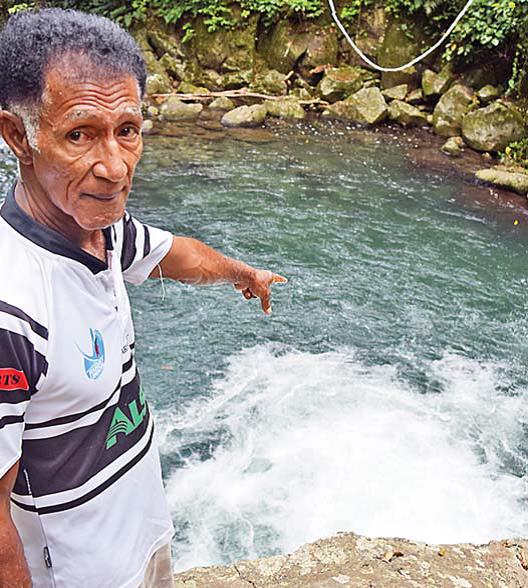Much is known about the Bouma and Lavena falls, at the northern end of Taveuni.
These cascading beauties have wowed tourists and locals the world over for decades.
But the lesser known Qeleni pools, in the district of Wainikeli, have their own wonders.
One thing that strikes you about the village is the gushing streams running along two sides of its boundary that finds its source deep within a jungle of native trees.
Villager elder, Alusio Neori, said Qeleni was blessed with its many pools and streams.
In fact, it has five well known pools – Nabuikilagi, Tobu ni ika droka (fresh fish pool), Tobu ni tavo (pool of wreckage), Tobu ni laione (lion pool)and Tobu ni vulagi (visitors’ pool).
Alusio, a retired policeman who has lived in the village most of his life, took us to the furthest pool – Tobu ni Tavo.
“I don’t have any more explanation about how the pool got its name but according to what I heard when I was growing up in the village, the Tobu ni tavo got its name from the manner in which it received huge logs and tree branches after a heavy downpour,” Alusio said.
“The pool is quite deep and rounded so logs that drift from the upper parts of the river often end up there.” As Alusio took us through a thicket of shrubs and under the shade of towering hardwood trees, he digressed to talk about Di Lutu, a female ghost who lived and walked within the village land boundary. “I was born here and grew up in the village as a boy. These ponds were always named.
However, Di Lutu did not have a pond named after her,” Alusio continued, removing creepers that got in our way.
“I’ve never seen her although I’ve always wanted to. According to what we know, she mostly makes appearances to unsuspecting male visitors or to punish and scare visitors who make a lot of noise within the village boundary.”
After descending a small hill covered with dense forest and hopping over slippery black rocks, the sound of water gushing from a short fall into Tobu ni tavo was heard in a distance.
The conversation went back to Di Lutu.
“Di Lutu is sometimes seen wandering in the mangrove swamp, along the beach or in the bush wearing sulu draped over her breasts. Those who have seen her say she is a very beautiful woman.”
“Her feet are positioned differently. If she walks on the beach she’d leave footprints that walk the opposite direction from her actual movements.”
When Tobu ni Tavo appeared, the sound of streams was blaring and almost echoing in the forest. There was no floating log in the pool, just green water, reflecting the lush emerald vegetation all around.
“This is it. It’s very cold and quite deep, especially in the middle,” Alusio said.
“We just went through a period of drought and all our village pools dried up. But after the recent rains the pools now have water and children can be seen dipping in the pools every single day.”
From Tobu ni tavo, Alusio led the way downstream, and at times, showing jumping skills as he manoeuvred his way around snaking streams by leaping from rock to rock. Living up to its name, the pool had many freshwater fish species that found swimmers strange and intimidating.
He suggested a dip in the Tobu ni ika because it was calmer and less deep. Sitting on a rock while he watched first timers take a swim, he continued with his story on Di Lutu.
“Last year, someone from the village picked her from along the road. She said she was going to attend a fundraising in the village but asked to be dropped at the beach. While she was getting off, the driver spotted her oddly positioned feet and knew instantly she wasn’t human. He came to the village and told people the story.”
“You may have heard of an accident that happened here a few years ago. A few people died because they were drinking and driving and making a lot of noise. People believed the driver saw Di Lutu on the road and got into an accident as he tried to veer away from her.”
Apart from being just a roadside village that enjoys many pools, Qeleni also receives tourists every once in a while.
During such time, visitors are normally given an introduction to village life and culture through a traditional presentation of sevusevu to the chief before they get a taste of the different facets of a Fijian village, its many and rich traditions and the different places to visit within its boundary.
There was a funeral in Qeleni on the day of the visit so walking to all the pools and talking to the village headman or chief was a challenge.
Nevertheless, the story that Alusio told around the ghost Di Lutu and Tobu ni tavo was good enough and worth revisiting another day.





